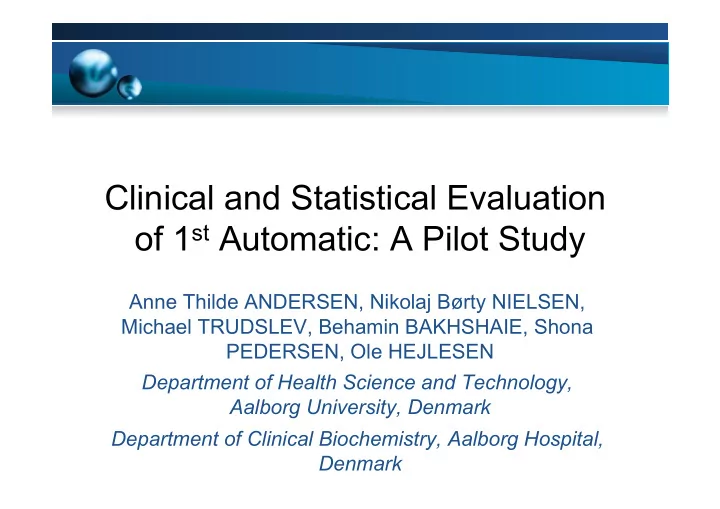

Clinical and Statistical Evaluation of 1 st Automatic: A Pilot Study Anne Thilde ANDERSEN, Nikolaj Børty NIELSEN, Michael TRUDSLEV, Behamin BAKHSHAIE, Shona PEDERSEN, Ole HEJLESEN Department of Health Science and Technology, Aalborg University, Denmark Department of Clinical Biochemistry, Aalborg Hospital, Denmark
The patient’s problem • Patients with respiratory disease are at risk of inadequate lung ventilation and inadequate tissue oxygenation • Patients with metabolic diseases are at risk of acid-base abnormalities • An arterial blood gas analysis is a simple procedure that can be performed bedside and can provide information about – lung ventilation, – tissue oxygenation and – acid-base status
The clinician’s problem • Medical personnel at the ICU are under considerable stress in their everyday clinical settings and therefore prone to make errors • 75% of all laboratory medical errors occur during the pre-analytical phase • An error in the pre-analytical phase of an arterial blood gas analysis can seriously influence the diagnosis and treatment
Errors • Common pre-analytical errors – Wrong patient identification – Air bubbles in the specimen – Insufficient mixing prior to analysis
1st Automatic • Partial automation developed by Radiometer – A partially automated bar code scanning system minimizes the risk of patient ID and specimen mix up significantly – Automatic mixing of the specimen ensures a consistently homogeneous specimen prior to analysis
1 st Automatic SafePICO • Needle cover • Pre-heparinised syringe • Integrated metal ball • SafeTIPCAP • Unique barcode Kilde: www.radiometer.com/1st
1 st Automatic FLEXQ 1. Scanning 2. Identification 3. Mixing 4. Analysing
Objective of the study • To assess whether 1st Automatic is a suitable alternative to the conventional method • To examine whether there is a difference between the two methods
Patients and Specimens • Department of Anaesthesia and Intensive Care, Aalborg Hospital • 5 patients randomly selected • 21 pairs of specimens – one specimen processed by the conventional method and – one specimen processed by 1st Automatic
Blood Gas Analysis • The nurse collected both specimens • Both specimens in a pair was analyzed by the same analyzer (ABL825 / ABL837) – One of the specimens in each pair was processed by the mounted FLEXQ module (performed by the observer) – the other specimen was processed manually (performed by the nurse) • Nine parameters: pH, pCO2, pO2, cNa+, cK+, cCa2+, cGlu, cLac and tHb.
Comparison of Procedures • Bland-Altman plots – depict the difference in the blood gas parameters for each pair of specimens (conventional method – 1st Automatic) as a function of the mean of the two specimens in a pair • Paired-sample t-tests • A mean difference of 10%, or less, of the normal range for each parameter was considered to be clinically insignificant
Results • 21 paired samples from five patients. The table shows the p-values of the T tests. The blood gas pressures (pXX) are in kPa and the blood concentrations (cXX) in mmol/.
Discussion • pH – t-test gives p = 0.082, which indicates that there might be a bias – However, the mean difference is around 1% of the normal range • pCO2 and pO2 – t-test shows p = 0.17 for pCO2, and p = 0.94 for pO2, which indicates that no bias – Mean difference is less than 2% and 1% respectively
• cNa+ – t-test shows p = 0.008, which is statistically significant – The mean difference is 0.714, which is 7% of the normal range • cK+ – t-test shows p = 0.80 – Mean difference of less than 1%, which indicates that that no bias is present
• cCa2+ and ctHb – t-test shows p = 0.002 for cCa2+ and p = 0.010 for ctHb – the difference being 10% and 1% respectively • cGlu and cLac – t-test shows p = 0.065 for cGlu and p = 0.25 for cLac – The difference is 5% and 3% respectively
Summary • There was a good consistency between the results using 1st Automatic and the conventional method. • It was not possible to show any clinically significant difference between the two procedures. • The consequences on workflow using the two procedures have not been addressed in the present study • 1st Automatic is now beeing used at the hospital
Acknowledgements • The FLEXQ, safePICO and 1st Automatic clients were provided by Radiometer Denmark • Thanks for their help – to Jan Pedersen at Department of Clinical Biochemistry, Aalborg Hospital, – to the staff at Thorax Intensive Care Unit, Department of Anaesthesia and Intensive Care, Aalborg Hospital, and – to Soren Lundbye-Christensen, Cardiovascular Research Centre, Aalborg Hospital
Recommend
More recommend